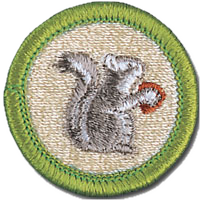Mammal Study


Resources
- Mammal Study Merit Badge Pamphlet
- Mammal Study Merit Badge Class Preparation Page
- Mammal Study Merit Badge Workbook
- Scoutmaster Bucky's Merit Badge Advancement Quick Reference
- Scoutmaster Bucky's Acknowledgement Form
Related
Mammal Study Requirements
Current Scouts BSA requirements
as of December 16, 2025
as of December 16, 2025
1.
Explain the following terms: animal, invertebrate, vertebrate, and
mammal. Name three characteristics that distinguish mammals from all
other animals.
2.
Explain how the animal kingdom is classified. Explain where mammals fit in
the classification of animals. Classify three mammals from phylum through
species.
3.
Do ONE of the following:
a.
Spend three hours in two different kinds of natural habitats or at
different elevations for a total of 6 hours. List the different mammal
species and how many of each you identified by sight or sign. Tell why
all mammals do not live in the same kind of habitat.
b.
Spend three hours on five different days in at least a 25-acre area
(about the size of 31/2 football fields) for a total of 15 hours. List
the mammal species you identified by sight or sign.
c.
From study and reading, write a simple life history of one nongame
mammal that lives in your area. Tell how this mammal lived before its
habitat was affected in any way by humans. Tell how it reproduces, what
it eats, and its natural habitat. Describe its dependency upon plants
and other animals (including humans), and how they depend upon it.
Describe how humans have benefited from the mammal you have chosen and
whether the mammal has benefited from association with humankind.
4.
Do ONE of the following:
a.
Under the guidance of a nature center or natural history museum, make
two study skins of rats or mice. Tell the uses of study skins and
mounted specimens respectively.
b.
Take good pictures of two kinds of mammals in the wild. Record the
date(s), time of day, weather conditions, approximate distance from the
animal, habitat conditions, and any other factors you feel may have
influenced the animal's activity and behavior.
c.
Write a life history of a native game mammal that lives in your area,
covering the points outlined in requirement 3(c). List sources for this
information.
d.
Make and bait a tracking pit. Report what mammals and other animals
came to the bait.
e.
Visit a natural history museum. Report on how specimens are prepared
and cataloged. Explain the purposes of museums.
f.
Write a report of 500 words on a book about a mammal species.
g.
Trace two possible food chains of carnivorous mammals from the soil
through four stages to the mammal.
5.
Working with your counselor, select and carry out one project that will
influence the numbers of one or more mammals.